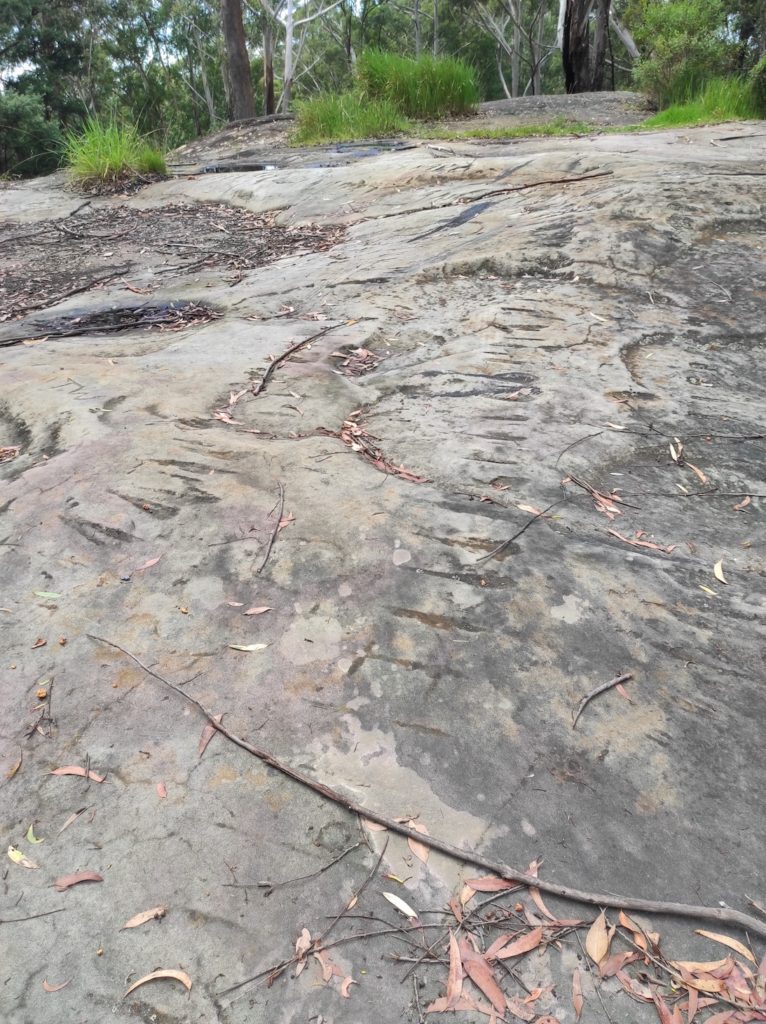The Department of Planning and Environment’s Biodiversity and Conservation Division is investigating obvious signs of destruction at a cultural site in Ourimbah State Forest.
The Camp Ourimbah campaign against forest logging says the incident begs the question of how well sites on the Central Coast are maintained by the bodies that are charged to protect them.
Camp Ourimbah spokesperson Ursula Da Silva said in Ourimbah State Forest, numerous and obvious machine marks scar the surface of a rock platform that contains ancient axe grinding grooves.
“Motorbike tyre skids run along the rock face,” she said.
“There is graffiti all over paintings in a nearby cave and what appears to be more scratching and damage done near another grinding groove.”
The discovery of damage on the rock platform triggered the Indigenous Party of Australia to come to Ourimbah and visit the site in November 2021.
Their findings were “disturbing” and led to the party contacting relevant ministers, the EDO and the EPA.
“The EPA has referred the matter to the Department of Planning and Environment’s Biodiversity and Conservation Division for investigation,” EPA Senior Media Advisor Andrew Thomas said late last year.
Darkinoong custodian Renee Sales doesn’t believe adequate protections exist at the site.
“Recent reports of vandalism at the nearby Bulgandry site and the slow response to create an action plan for prevention of damage to Bulgandry is distressing at worst,” she said.
“But to see the lack of proper care and protection of an already damaged site at Ourimbah shows me Forestry Corporation NSW (FCNSW) is not taking adequate measures to protect our cultural heritage, which is heartbreaking.
“Signs exist at either end of this cultural site which sits in the middle of a logging compartment.
“These signs list forms of prohibited damage including damaging, scratching, driving vehicles over and impacting the fabric of the rock or artefact and altering the cultural values of the place.
“These offences can result in fines of up to $1.1M and imprisonment.
“The irony is that every single form of damage listed in these signs has already occurred.
“While it is good that gates now exist to stop car dumping, there are no signs indicating areas of significance on the rock platform.
“There is no information explaining the significance of this area.
“There are no fenced-off areas protecting paintings or grinding grooves – not even from motorbikes.
“There is nothing to educate the public.
“The area is neglected and nothing is in place to encourage understanding of the cultural site.

“Delegates from the Asia-Pacific Forestry Commission were given a tour of the forest while the majority of the local community remains uneducated and unaware of the history and significance of this area.”
Da Silva said machine marks all over the rock platform contradicted FCNSW’s stated intention of exploring every avenue to avoid harming Aboriginal sites.
A Forestry Corporation spokesperson said Ourimbah State Forest, which was dedicated in 1916 and has been harvested and regrown for more than 100 years, has more than 100 recorded cultural heritage sites that are protected from forestry operations and in most cases not accessible to the public.
“Where forestry operations occur, cultural heritage sites are mapped and protected in consultation with the local Aboriginal community representatives and machinery is fitted with GPS tracking to monitor movements and ensure compliance with the marked protections,” they said.
“Sadly, damage to rock platforms in general may have occurred as early as the 1920s when bulldozers began to be used for track construction while rock damage and graffiti on this site seems to have occurred many years or decades ago, prior to the introduction or improvements to cultural heritage and environmental legislation, land management processes, and community awareness.
“The area has previously been assessed by the Local Aboriginal Land Council and other community representatives who shared their knowledge and experience by providing management and conservation recommendations.”
The spokesperson said while most forest users visited responsibly, previously parts of Ourimbah State Forest had been subject to substantial vandalism, including severe surface damage from four-wheel drives and motorbikes and dumping of vehicles.
“As a result, in 2020 Forestry Corporation, in consultation with the local police, RFS, Central Coast Council, the local Aboriginal community and residents, closed Wallaby Rd and Middle Ridge Rd and installed barriers to restrict access and help protect environmental and cultural heritage values in this forest.”
Terry Collins



It’s disappointing when 1 of Australia,s Only living World History, Is being mutilated all around Australia to make way for what ? Mining,Developments ?? Or to wipe, 1 of the World oldest existence, out of nastiness! The Australian Government’s needs to be putting more funds,into our Local Aboriginal Lands Councils, for the very purpose of protection to these our Australian heritage historical sites! That should be gathered & registered,as such within archives! & also can be used as part of Australia & Local Tourist information, at the appropriate approval; of Local Elders & Local Aboriginal Lands Councils. Stop the Desacration of our 1st Nations & Australia’s Aboriginal Native History.